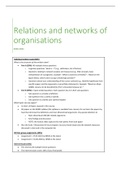Summary
Very extensive and precise summary of Relations And Network Organizations (441057-B-6)
- Course
- Institution
I made this very extensive and precise summary of all lectures, except lecture 10. I always try to use figures and graphs to make lectures easier to grasp. I also included all relevant information from the literature to the lectures and added some pracice questions.
[Show more]



